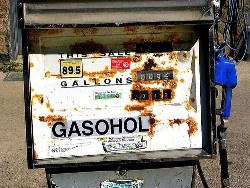Biofuels Update: How is the Industry Doing?
 VEETC Expiration, Ethanol Exports & Oil Imports
VEETC Expiration, Ethanol Exports & Oil ImportsFor those of you who missed it, the corn ethanol lobby failed to convince Congress to extend the ethanol import tariff (54 cents/gallon) as well as the blenders tax credit (46 cents/gallon), which were slated to expire at the end of 2011 …sound of crickets chirping.
My guess is that because we exported almost 9% of our ethanol production last year, it was hard to argue that we still needed a tariff to protect us from Brazilian ethanol imports, especially since Brazil was our biggest customer. In a related vein, it should also be hard to argue that we mandate ethanol use to reduce oil imports while exporting ethanol to Canada (second largest customer and largest oil importer) as well as the United Arab Emirates (our fifth largest customer).
As for the tax credit, well, paying oil companies to blend something they were already legally mandated to blend never did make much sense, except maybe to the oil companies who were not about to look that gift horse in the mouth.
Mandate, E15, Food Prices, Cellulosic Ethanol
Even with continued mandated use and an increase in blend percentage from 10 percent to 15 for newer cars, most corn ethanol producers are operating in the red so far this year because the lower demand for gasoline has also resulted in a lower demand for ethanol. Some refineries are closing. From Reuters:
Archer Daniels Midland on Monday said it will close its ethanol plant in Walhalla, North Dakota, marking the first such closure for the agribusiness giant that last month announced the elimination of 1,000 jobs.
A spokesperson for the company said that the closure was not related to the expiration of the blending credit.
It has been suggested by some (half-seriously) that corn ethanol is more or less a process to convert natural gas into a liquid fuel, but apparently the record low prices for natural gas are being nullified by the record high prices of corn:
ADM last week reported sharply lower earnings, with the company earning less money in almost all of its major units as it struggles with high commodity costs.
Brazilian cane ethanol has been on a roller coaster for the past couple of years. Back when sugar prices hit historic highs, Brazil greatly reduced the amount of ethanol blended into its gas and increased imports of cheaper (corn) ethanol.
We may be witnessing the wave of the future for fuels that compete for food crops. Because we can’t control the weather we can’t control crop yields, and when food prices start to soar, well, let me put it this way, biofuels made from food crops don’t do much to alleviate the problem.
On the bright side (at least to wildlife conservationist types) the EPA shot down biodiesel made from palm oil. By their calculations it fails “to qualify as meeting the minimum 20% GHG performance threshold for renewable fuel under the RFS program.”
As for cellulosic ethanol, it remains perpetually just five years away from commercial viability.
You can return to the main Market News page, or press the Back button on your browser.

